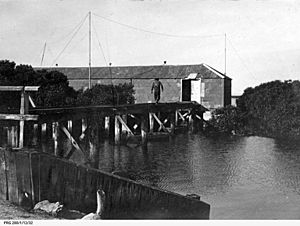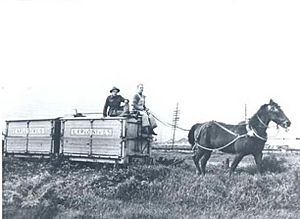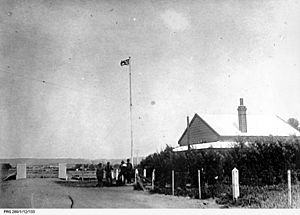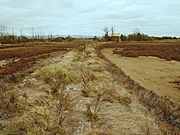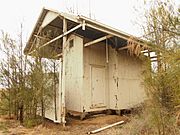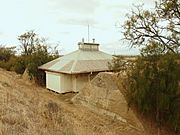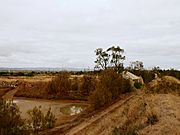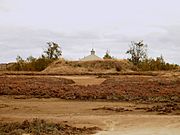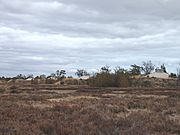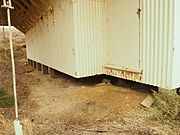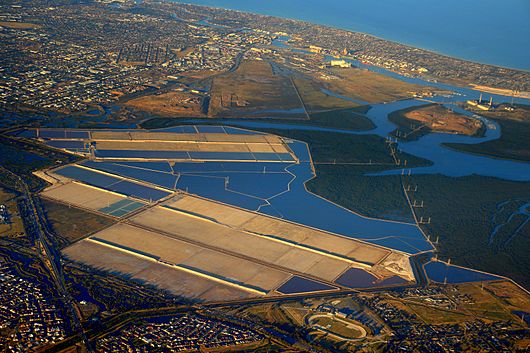Dry Creek explosives depot facts for kids
Quick facts for kids Dry Creek Explosives Magazine |
|
|---|---|
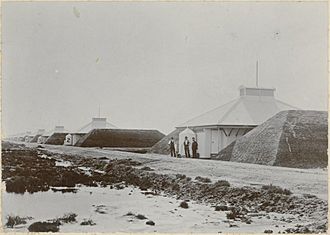
Powder magazines at Dry Creek
|
|
| General information | |
| Status | Unoccupied |
| Type | Government magazine |
| Address | via Port River Expressway and Magazine Road |
| Town or city | Dry Creek |
| Country | Australia |
| Coordinates | 34°49′42″S 138°34′48″E / 34.828347°S 138.579980°E |
| Construction started | 1906 |
| Completed | 1906 |
| Owner | South Australian Government |
| Dimensions | |
| Other dimensions | 200 metres (660 ft) wide by 1,000 metres (3,300 ft) long |
The Dry Creek explosives depot was a special place near Port Adelaide where dangerous materials like explosives were kept safe. It was used from 1906 until 1995. This depot helped industries in South Australia that built things, dug for minerals, or worked in quarries. It also supplied mines in Broken Hill, New South Wales.
Contents
Building the Explosives Depot
The Dry Creek explosives depot had ten storage buildings called magazines. They were built in 1906 at a place called Broad Creek. This area is a tidal channel on the eastern side of the Barker Inlet near the Port River Estuary.
The Broad Creek site was chosen because it was far away from Port Adelaide. It replaced an older explosives depot called North Arm Powder Magazine. This new location was safer because it was more isolated.
The Horse Tramway
In 1906, a special narrow railway track was built. It was about 2 kilometers (1¼ miles) long. This track connected the depot to a landing jetty on one side. On the other side, it connected to the Dry Creek railway station.
Six special wagons were used to carry explosives like dynamite to the magazines. Each wagon could hold about 1¼ tons of explosives. Horses pulled these wagons. Before this tramway, explosives had to be moved by road, which was both risky and costly. In 1978, these wagons were given to the Illawarra Light Railway Museum, where you can see them today.
How the Depot Worked
The outside walls of the magazines were usually painted with limewash. This helped keep them cool. Great care was taken to protect the explosives from dampness, heat, and dirt. The buildings had special insulated walls. They were designed to stay naturally cool and well-ventilated. Their ventilation openings had metal covers to stop sparks and dust.
High tides, known as king tides, often flooded the area. This frequently damaged the tramway track that ran along the mangroves to the jetty. In July 1917, the jetty was washed away by the highest tide ever recorded at that time.
Why the Depot Closed
By 1925, explosives were delivered less often but in bigger amounts. This meant fewer explosives came through the jetty. The number of workers at the port went down, and the depot earned less money.
By 1934, the wooden structures were getting weak from shipworm and not being fixed. From 1934, explosives started arriving by train directly from Victoria. By 1947, all explosives were delivered this way. The jetty was last used in 1970 and taken down around 1976.
As less trade happened by water, explosives started being moved more by land. Also, new ways of using explosives developed. From 1978, a new ingredient called ammonium nitrate became popular. This meant explosives could be mixed right where they were needed. This made things safer and changed how explosives were stored. It also meant less checking and storing was needed at the depot.
The Dry Creek explosives depot stopped operating in October 1995.
Today's Condition
Eleven of the old buildings at Dry Creek, built between 1903 and 1907, are still standing. They were added to the South Australian Heritage Register in 1994. In 2000, they were in good shape. However, the metal bars inside the concrete supports are rusting because of the salty soil. This might threaten their long-term stability.
You can still see parts of the old wharf and the narrow railway line if you explore Broad Creek by canoe.


